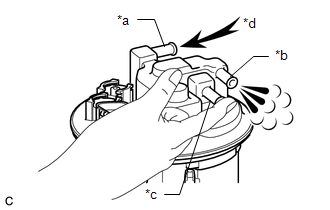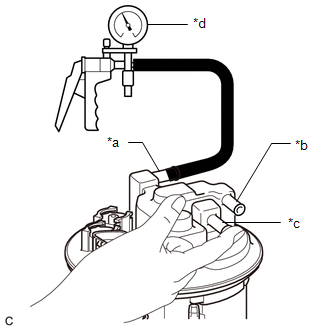Toyota Yaris: Canister / Inspection
INSPECTION
PROCEDURE
1. CHECK CANISTER (FUEL SUCTION WITH PUMP AND GAUGE TUBE ASSEMBLY)
(a) Visually check the canister (fuel suction with pump and gauge tube assembly).
(1) Visually check the canister (fuel suction with pump and gauge tube assembly) for cracks or damage.
If cracks or damage are found, replace the canister (fuel suction with pump and gauge tube assembly).
(b) Inspect the airflow of the canister (fuel suction with pump and gauge tube assembly).
| (1) Close the port (B) and check that air flows from the port (A) when air is blown into the port (C). OK: Air flows from the port (A). |
|
(c) Inspect the check valve.
| (1) Close the port (C) and check that air flows from the port (B) when air is blown into the port (A). OK: Air flows from the port (B). |
|
| (2) Using a vacuum pump, apply vacuum to the port (A) with the port (C) closed and check that air flows into the port (B). OK: The vacuum is maintained at first. By gradually increasing the vacuum, air flows and the vacuum decreases after the vacuum reaches a certain level. |
|
 Removal
Removal
REMOVAL CAUTION / NOTICE / HINT The necessary procedures (adjustment, calibration, initialization or registration) that must be performed after parts are removed and installed, or replaced during canister (fuel suction plate sub-assembly) removal/installation are shown below...
 Installation
Installation
INSTALLATION PROCEDURE 1. INSTALL FUEL MAIN VALVE ASSEMBLY Click here
2. INSTALL FUEL PUMP Click here
3. INSTALL FUEL SENDER GAUGE ASSEMBLY Click here
4...
Other information:
Toyota Yaris XP210 (2020-2026) Owner's Manual: Battery Runs Out
Jump-Starting Jump-starting is dangerous if done incorrectly. So follow the procedure carefully. If you feel unsure about jump-starting, we strongly recommend that you have a competent service technician do the work. Move the booster vehicle so that its battery is as close as possible to your vehicle’s battery...
Toyota Yaris XP210 (2020-2026) Reapir and Service Manual: Components
C..
Categories
- Manuals Home
- Toyota Yaris Owners Manual
- Toyota Yaris Service Manual
- Adjustment
- Diagnostic Trouble Code Chart
- Maintenance
- New on site
- Most important about car
Fuel Gauge
The fuel gauge shows approximately how much fuel is remaining in the tank when the ignition is switched ON. We recommend keeping the tank over 1/4 full.




